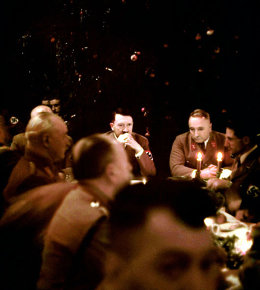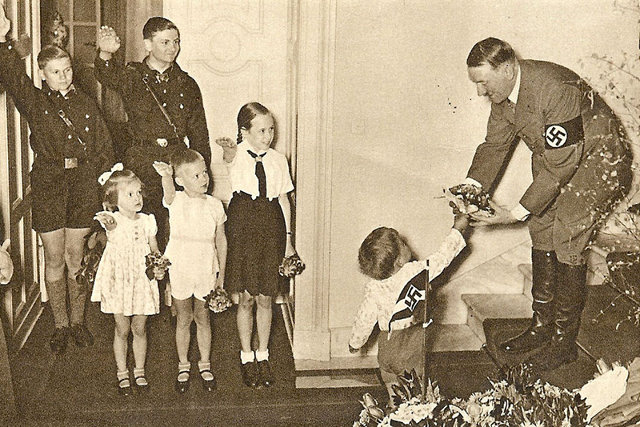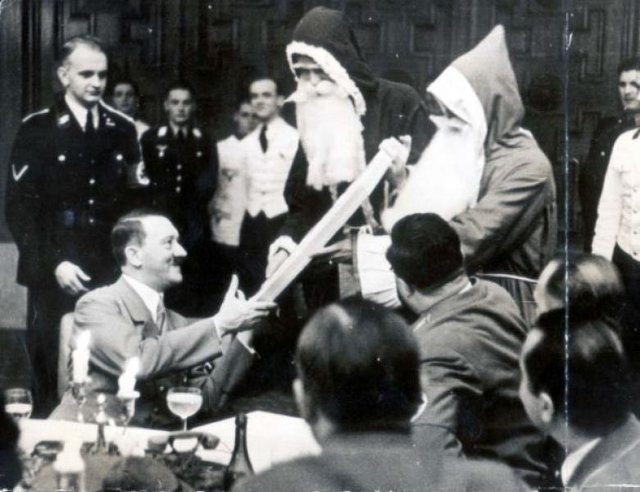In December 1941, Adolf Hitler threw a Christmas Party for his fellow Nazis. It was a lavish affair, in which the Nazi Party's top officials, statesmen and generals gathered before a massive Christmas tree to feast and exchange presents with hundreds of jackbooted S.S. cadets in attendance.

In surviving pictures taken by the Führer's own personal photographer, Hitler appears somewhat dour and maybe a little sad to be at this event, as if he feels out of place despite his importance, and no wonder: What holiday could be less suited to the sentiments of that genocidal, warmongering dictator than a Christian holiday celebrating the birth of a Jew?
Yet despite the expression on his face, Hitler sits in these pictures as a conqueror, not just of continental Europe, but also of Christmas--a holiday than in just six years, he managed to redesign into a potent propaganda tool.
Peace On Earth
It wasn't easy. Back during World War II, Germany's population was predominantly Christian. Then as now, Christmas was a popular holiday to celebrate among Germans; in fact, the modern-day Christmas tree actually traces its roots back to the Rhineland in the 16th century. Christmas was too important to Germans for the Nazis to get rid of, yet it represented everything that Hitler despised: the Christian ethic of peace on Earth. He couldn't get rid of it, but he could try to make it his own.
A propaganda article from 1937 entitled New Meanings For "Inherited Customs" shows the considerable mental aerobics that the Nazis had to go through to turn Christmas into a holiday they could broadly support. Christmas is traditionally viewed as a "holiday about a theoretical peace for all humanity,"--an interpretation should be rejected, the article said. (It is hard, after all, to wish peace to all men when you are simultaneously drafting up plans to shove millions of them into gas chambers.) Realizing this, the article's author said that Germans should instead present Christmas as a "holiday of actual domestic national peace," a peace which could presumably only be facilitated by getting rid of enemies of the state such as Jews, gypsies, communists, and homosexuals.
Killing Off Jesus & Santa
Hitler's propaganda war on Christmas by no means ended there. He also set out to get the 'Christ' out of Christmas. Unlike in English, Christmas is called Weihnachten in German, so the actual name of the holiday did not require modification to suit the goals of an anti-clerical Führer. Even so, the Nazis preferred a different name for Christmas: Rauhnacht, the Rough Night, which had a tantalizing hint of violence to it.
But many of the trappings of Christmas are inherently religious, right down to the purported event being celebrated: the birth of Jesus Christ. Luckily for Hitler, Germans had celebrated the winter solstice long before Christianity came to the country. It was fairly easy for Nazi propagandists, therefore, to reclaim Weihnachten as a pagan holiday in which the longest days of winter were marked by gift-giving and a festival of lights.

Songs that mentioned Jesus, like Silent Night, were rewritten with new lyrics espousing the benefits of National Socialism by none other than chief Nazi ideologist Alfred Rosenberg and Heinrich Himmler, one of the masterminds of the Holocaust. At the height of Nazi Christmas revisionism, any mentions of the Savior were replaced with mentions of the "Savior Führer."
Jesus had been taken care of, but Santa Claus was not so easily forgotten. Tracing his roots to St. Nicholas of Myra, a fourth-century Greek Christian bishop from Turkey, Santa was both explicitly Christian and very definitely not Aryan. Even so, Santa was so beloved that not even the Nazis felt that they could wage a war against him. Instead, they changed his name. Nazis argued that the white-robed and gray-bearded figure who came to people's houses and gave them gifts on Christmas Day was really the pagan god Odin. Christians had merely stolen him, but now he had been reclaimed.
Christmas Tree Decorations

Other aspects of Christmas had to change, too. Although the modern Christmas tree is an explicitly German invention, the star that is traditionally placed on the top represented a problem for Nazis: either it is a six-pointed star, and becomes the Star of David, or it's a five-pointed star, and resembles the red star of Communism. Ideologically, neither would do. Instead, the Nazis encouraged revelers to place a swastika, a German sun wheel, or a sig rune (the lightning-shaped symbol used in the emblem of the SS) atop their trees instead.
Christmas tree decorations also changed. In general, ornaments became a lot more warlike, and it was not uncommon to hang replica grenades and machine guns on your Christmas tree during the Nazi years. But they also became increasingly jingoistic. Surviving ornaments from the Nazi era include silver balls emblazoned with mottos such as "Sieg heil!" red bulbs covered in swastikas, and tchotchkes shaped like Iron Crosses and eagles. There are even ornaments that are just tiny metal Hitler heads (complete with mustache). To his credit, though, even Hitler didn't like these, leading to laws to prevent Nazi symbols from being misused for Christmas kitsch
The Ghost Of Christmas Future
By 1939, just six years after Hitler came to power, Christmas had been totally transformed into a tool of Nazi propaganda. A contemporary article asserts that "when we celebrate a German Christmas, we include in the circle of the family all those who are of German blood, and who affirm their German ethnicity, all those who came before us and who will come after us, all those whom fate did not allow to live within the borders of our Reich, or who are doing their duty in foreign lands amidst foreign peoples."

"We cannot accept that a German Christmas tree has anything to do with a crib in a manger in Bethlehem,"]wrote the Nazi propagandist Friedrich Rehm in 1937. He added, "It is inconceivable for us that Christmas and all its deep soulful content is the product of an oriental religion."
Yet Hitler's redesign of Christmas didn't last long. As the Allies advanced, by 1944, worrying about the Christian influences on Christmas was the least of the Nazis' problems, and the holiday was rebranded as a day of remembrance for those who had been lost in the war.
1944 was also the year of last Nazi Christmas. Just four months later, the Führer was dead, and while a few of Himmler's hymns were briefly sung in post-war Germany, the survivors of the war did with Hitler's Christmas what they did with every other idea the Nazis had come up with: denounced it and buried it.
Perhaps that's what explains the strange, sad expression on Hitler's face, sitting there at a table with all his thugs on Christmas, 1941. Maybe he has seen the ghost of Christmas future.